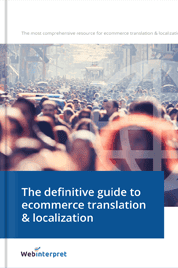
Grow international sales with eBay size conversions charts
If you want to expand your online business and start selling on international markets, you should be familiar with international size charts.
Sizes and dimensions are crucial product attributes, especially when you sell clothes and accessories.
Standard translation tools can take care of your international listings, but won’t be able to convert sizes and other specs. And incorrect translations can cost your ecommerce business lost orders and returned products.
Consider a smarter approach to localizing and accurately converting sizes and dimensions to boost your international eBay sales.
Sizes in fashion listings on Ebay
Sizes are a common attribute in ecommerce listings. According to Webinterpret’s original research, around 22% of monthly eBay items in the Clothes category contain sizes.
After all, the global online fashion sector turned over $863bn in 2022, accounting for around a fifth of the world’s ecommerce.
Are you one of the international marketplace sellers offering sized products in your online store? Then try to put yourself in your buyers’ shoes for a moment:
Imagine you live in France, and you’re shopping online for a dress for a special occasion. You browse offers from French stores, but the clothes are expensive. So you check cocktail dress listings on your favorite international marketplace and find a beautiful selection from a British online merchant.
The only problem is the size. You’re looking for a dress in size 38, but the online store carries sizes 7, 8, 9, and 10. You’re not sure which to choose.
How do you think that makes the online shopper feel?
Different, unrecognizable sizes confuse buyers. Even if a customer is committed to making a purchase, an unfamiliar size might cause doubt and make them shop elsewhere.
Metric systems and sizes are nuanced around the world: size 8 in the UK may be size 4 in the USA, but size 36 in Germany, and some brands might also mark it as S size. And so on. How should online sellers approach this?
If you sell on international marketplaces, you need to translate product attributes as well as localize sizes.
Size conversion vs. customer experience and competition
According to the 2023 Global Fashion Report from RetailX:
80% of online fashion shoppers are driven by convenience.
It is understandable that users may get confused when buying clothes or shoes on the internet – especially if they’re not buying them on their domestic markets. In many cases, online shoppers are concerned that the item they’re buying may not be the correct size and will not fit.
This is the reason why fashion sellers must be very precise when they specify the sizes of the clothes or shoes they are selling online in foreign markets.
What if they’re not? Some customers might shy away from listings that do not prioritize accomodating clear ecommerce size translations.
Do not assume that:
- Online fashion shoppers know the difference between sizes in the UK, Germany, France, and the US by heart.
- Interested buyers can look up size charts online.
- If the potential customers need to, they can ask sellers about sizes directly.
Such assumptions are wrong and contribute to bad customer experience. But not just that:
Making the buyer look up sizes or use currency converters pushes them one away from the “buy now” button.
How will this affect you as an online seller?
- You will lose international customers to your competition that clearly marks international size charts and conversions
- Your international return rates may significantly go up and managing returned items will further cost you money.
- Disappointed buyers might even leave you bad reviews that will lower your seller ratings.
It’s a competitive market out there. Going the extra mile to understand and cater to your buyers’ needs can improve the customer experience. And ultimately, help win their loyalty.
More often than not, busy buyers are drawn to online sellers who exhibit respect for their time. Those are the merchants who convert sizes for their international customers. And as such, they can expect more orders.
You don’t want to be one of the sellers that are overlooked at the start due to unnecessary purchase barriers.
Tools for international size conversion on eBay
If you’re in the business of selling clothes online and have ventured into international markets, you need to be well-acquainted with international size conversion charts, such as eBay conversion charts. This handy tool is every online seller’s passport to seamless cross-border sales.
Conversion charts translate units of one system of measurement into corresponding units of another.
By indicating relations between international sizes, they enable foreign online buyers to choose the correct sizes.
When the proper size and measurement conversions are clearly stated in the listing, it instantly boosts buyer confidence and reduces the risk of returns.
Unfortunately, standard automated translation tools are unlikely to properly localize international sizes. Why is that?

As Flore Morin further explains: “Ecommerce translation is simply the changing of words and phrases from one language to another. It doesn’t take into account the cultural differences between people of the source countries and those of the target markets.
As for localization, this is an adaptation of an online store to a new language and culture, in ecommerce terms. It is not only about text translation, but also about currency and size conversion, communication, legal restrictions, local marketing and many other aspects”.
Only proper ecommerce-optimized translation tools can provide seamless localization and pick up sizes from the context of your listing.
Take Webinterpret’s solution for marketplace merchants as an example:
- It translates sizes and additionally, offers customized size conversion for eBay sellers, which Google doesn’t support.
- Size translation is configurable by individual merchants: sellers can declare whether they want to translate particular brands that have their own conversion charts, and if needed – provide their own translations.
- Webinterpret’s library has over 700 default manufacturers’ charts and around 12,000 custom sellers’ charts.
This AI-driven tool is able to identify which chart to apply by checking the item’s context: a component name (to detect if size conversion is applicable), brand name, category, sites and seller ID.
Size conversion and product searchability
In international ecommerce, size conversion also affects the searchability aspect of marketplace listings.
Imagine you live in the UK and are looking to buy Converse shoes in size 8 on eBay. You type in “Converse shoes UK 8” directly in the search bar. The search results that are most likely to be displayed first will be the listings with Converse shoes available in this particular size, i.e. UK 8.
However, a French buyer looking for the same shoes on French eBay would probably search for “Chaussures Converse 38′ (“chaussures” means shoes). All UK listings that were not converted to the French 38 size 38 would then display at the bottom of the page results.
According to Noemie Colin, Senior Product Manager at Webinterpret specializing in ecommerce advertising, size conversion is mandatory for ensuring clarity when selling internationally:
Size conversion is an important aspect of the localization process for any ecommerce store. It’s to meet the buyer’s expectations, but also to increase the visibility and searchability of products.
We also see sellers trying to convert sizes by adding country prefixes, e.g. converting “UK 8” into “FR 38”. The version with the prefix, however, will be less searchable than just “38” which is less restrictive for search filters used on eBay.
Noemie’s recommendation for eBay fashion sellers creating their own conversion charts via the Webinterpret interface would be to remove the country prefix, e.g. UK, FR. This will improve item visibility in eBay search results, organic and paid.
Other measurement conversion in international ecommerce
Conversion of sizes is necessary in a number of ecommerce categories. Fashion is the most obvious one, but size specifications also appear on many other products, e.g. car parts.
The reality is that all items that are differentiated by dimensions need to be double-checked for size conversion when listed abroad. Why?
Because different countries, but also manufacturers and individual sellers, can use various systems of measurement.
The fundamental units of measurement encompass length, mass, and capacity. Dimensions are represented by numerical values followed by units specific to each measurement system.
The metric system operates with units such as meters, centimeters, and kilograms. The imperial system uses units such as feet, inches, and pounds.
The metric and imperial systems are not interchangeable.
In trade, weights and measures are often the subject of governmental regulation to ensure fairness and transparency. The International Bureau of Weights and Measures (BIPM) is tasked with ensuring worldwide uniformity of measurements and their traceability to the International System of Units (SI).
Meanwhile, Google Translator doesn’t support dimension conversion at all. Relying on such tools for accurate measurement translation can further harm your listings’ visibility.
If buyers don’t recognize the metric, they may not bother to look it up. Instead, they will choose a listing containing familiar units.
Even some of the more advanced translation solutions might still lack accuracy in case of marketplace-specific restrictions. For example, some types of products on eBay, like TV or computer screens, would be required to keep the size in inches for all sites. Only an ecommerce-dedicated translation tool will take measurement nuances into consideration by default.
 Hassle-free size localization on eBay and other marketplaces
Hassle-free size localization on eBay and other marketplaces
Remember that correct size conversion can increase international sales.
A solid product portfolio is no longer enough to attract foreign buyers. Unconverted sizes or wrong dimensions from Google Translate can hurt not just your revenue, but reputation as well.
Embracing precise size conversion can help you unlock a world of opportunities.
Ecommerce-optimized technology can ensure the correct translation of sizes and dimensions in your product specifications, and thus help take care of size charts that will grow your international sales.
Webinterpret’s AI-based solution helps eBay and other marketplace sellers optimize localization processes and costs. Our marketplace offer is constantly expanding so if you want to grow your online sales, feel free to contact our sales experts.

To find out how to translate and localize in a way that sells, download our FREE ebook!
Related Posts:
Ecommerce Newsletter
By clicking the “Subscribe now” button, you agree to receive our monthly e-mail newsletter and regular marketing and commercial communications by email from Webinterpret regarding marketing trends and our digital marketing services. You confirm that you have read and agreed to Webinterpret’s Terms of Service and Privacy Policy.

 Hassle-free size localization on eBay and other marketplaces
Hassle-free size localization on eBay and other marketplaces

